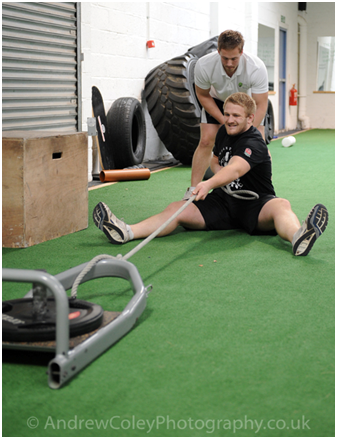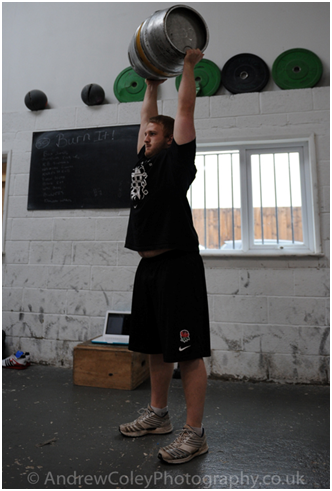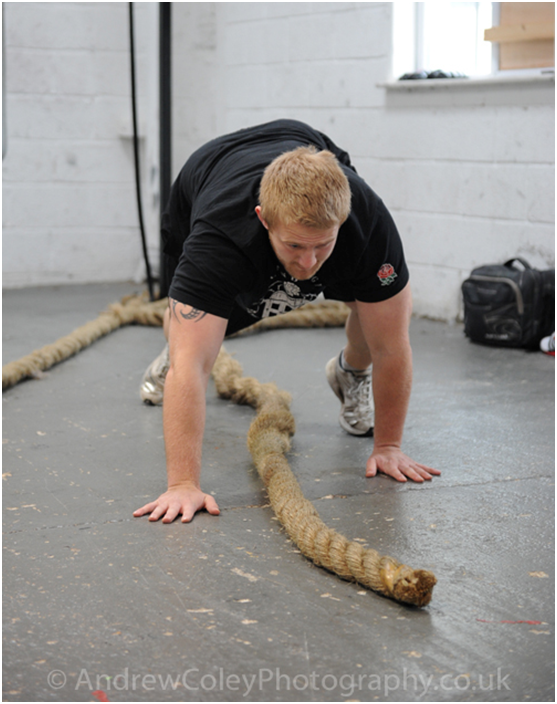PART 1: Featured Training
To those of you that have now finished your rugby season, I hope it was a good one!
I have already had players asking me about pre-season training. A common and very costly error that players often make is to train too early and too intensely. At this stage of the season it is very important NOT to neglect rest and recovery. That doesn’t mean have the summer off, but ensure you take into account appropriate recovery strategies and corrective injury prevention exercises before rushing back to training. With this in mind, be sure to keep your eye on our Rugby Sports Injuries Blog for tips regarding appropriate (p)rehab.
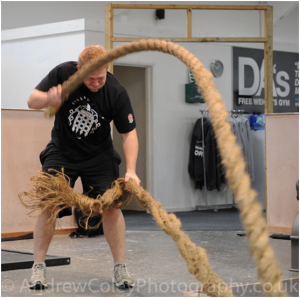
Heavy Rope Swings
Only the other day I was reading about the high percentage of fatigue related injuries at the start of the amateur rugby season. Accordingly, it is important that your pre-season training prepares you for the physical and metabolic demands of the game. By determining realistic aims and goals for the preseason phase, your training can be periodized to peak as the season starts. Unfortunately, it is not as simple as piling a load of muscle mass on over the pre-season period or stripping fat for a few months. There are a number of physical attributes required for rugby that need to be included in your training plan.
For those of you looking to be fitter next season, welcome to Metabolic Interval Training. If you are looking to strip body fat over this pre-season, this type of training is perfect. Metabolic training can be structured to mimic the work-to-rest ratios and demands of rugby in order to optimize training specificity. In a typical training week, this type of training can be done alongside developing other fitness components.
Recent time-motion analysis studies have reported quantity and duration of specific high intensity (sprinting, high speed runs, runs and static exertions) and low intensity (jogging, walking and standing) work activities in a rugby game. However, such detailed analysis of each specific movement activity in isolation is not a true reflection of the metabolic demands during a match. It is a combination of these specific activities performed immediately after each other during phases of the game, which commonly cause the greatest fatigue. In line with this, I like to use a combination of transferable exercises relevant to rugby; these sessions are fast paced, varied, and consist of intervals of hard work followed by short rest periods appropriate to the positional demands on field.
This type of training is heavily backed up by science with it being shown to have a ten-fold greater fat loss when compared to either aerobic exercise or weight training individually. These results have been reported in a number of Strength and Conditioning and Physiology Journals. Furthermore, the reality is that if you want your training to crossover onto the rugby pitch, you shouldn’t be going out for team 10-mile runs, as this is not relevant to the demands of the game.
For those of you that are aspiring pro’s; according to research a rugby players’ fitness level is suggested to be indicative of playing level, with match intensity increasing linearly with playing standard.
Furthermore, this is linked with their ability to exhibit high levels of skill under pressure and fatigue. So fitter definitely appears better!
PART 2: Player Introduction

Before I show you some of the exercises that can be used in these sessions, I would like to introduce you to Richard Townsend.
Rich is a Prop/Hooker and is currently making a move across to Ealing Trailfinders Rugby Club (National 1).
As an England Students and Hartpury rugby player, he has been exposed to a good amount of strength and conditioning.
I am working with Rich for the next month prior to his move.
We wish him the best of luck at his new club!
PART 3: Exercise Selection
In a given session players can experience a combination of resistance exercises, body weight exercises, plyometrics, Olympic lifts, kettlebell movements, running activities and strongman events. If you think of it like a rugby match, there is a considerable amount of variation in the activities carried out across a game and so by applying these to the training room, you should come back fit to play.
For this blog I have used equipment that is reasonably easily accessible and can be kept at your rugby club for training sessions. To give you an insight into some of the work I have done with Rich as a front row player, I have used a number of activities that utilize wrestling/grappling movements. Given his position, Metabolic Interval Training that combines this physical work with running will provide a close match between both the energy system and physical task demands of forwards’ match play. In terms of his work to rest ratios, they obviously vary but to ensure the work periods are sufficiently long (20-40 seconds) and rest periods are long enough to allow athletes to repeat the work but not recover entirely (40-90 seconds).
With regards to its interval application, it may be a good idea to run your session as a circuit with each station consisting of different relevant exercises, followed by the allocated rest/active recovery/light activity.
So here are five exercises that you could incorporate into your fitness programme alongside some of the others I have previously discussed in the other Rugby Fitness Blogs (running activity, tyre throws etc.).
1. Upper body sled pull
A lot of coaches use the sled for resisted sprint work, but it can also be used to develop dynamic upper body strength and power. The sheer volume of grappling type movement patterns used in rugby most definitely makes this exercise transferable in terms of its rugby application. By pulling the sled in an explosive manner you will immediately have visible feedback through the slackness in the rope and distance the sled has travelled. This form of feedback is great for players and can be used when target setting. This movement can be applied to tackling, ripping and maintaining possession of the ball.
The picture below demonstrates the basic movement required for completing this exercise but to make it more advanced and even more specific, carry out the movement on your feet.
This exercise is very safe since there is no eccentric phase and has huge upper body and core engagement when carried out both from the floor and on your feet. I personally think this is awesome for team sessions as not only is it economical but sled pulling races can be a real good way of making your athletes work harder without realizing.
2. Keg press
Shoulder injuries are prevalent in rugby with 20% of all rugby injuries deriving from this area of the body. To help prevent these injuries, shoulder strength and structural balance is required. One very accessible way of including this exercise in your training plan is to use an old keg from the clubhouse.
Keg press not only strengthens the shoulders and triceps but also requires core stabilization. In order to advance this exercise, carry out the keg press from the bottom of a squat position almost like a lineout lift.
This exercise can be used to effectively develop strength and power through varying loads.
Furthermore, with recent psychological research demonstrating a sense of security in the contact area for players that regularly train this area and have structurally balanced shoulders, there is the potential for your performance to be enhanced through this training method too.
3. Tyre flip and jump
The start position of a correctly performed tyre flip is similar to the scrum whereby the torso is nearly parallel to the ground. In order to initiate this movement a powerful forward drive of the hip extensors is required, while keeping the torso rigid and flat.
Once the tyre reaches full hip height, a powerful triple extension as seen in sprint accelerations, rugby tackles and rucks is vital to drive through into the final push position. In order to complete the flip powerful shoulder, tricep, core, leg and pectoral strength/power is essential.
Upon completion of the flip, the jump component requires co-ordination, balance and aspects of agility and explosive power. This jump can also be a great way of setting the player up to carry out multiple flips within a small area.
Consecutive flips and jumps will develop a player’s anaerobic capacity, with this being very relevant to rugby. Better still, research has actually proved that this exercise enhances high degrees of trunk muscle activation and core strengthening.
4. Heavy rope swings
Wrap the rope around your rugby posts, a tree or have a partner hold the other end of the rope and you are ready for action. This exercise can be carried out using an underhand or overhand grip with the aim being to simply create waves with the rope maintaining high amounts of velocity and power for an allocated time period.
As a target I like my players to ensure the flow of waves remain as big and continuous as possible.
When advancing this exercise you can add shuffling movements side to side and backwards or forwards, meaning the exercise is carried out across a number of angles. Training with these ropes requires huge amounts of functional strength. As a result of this training method, you will develop shoulder, core and grip strength. Furthermore the intensity of this training will require large amounts of energy and so you will be burning calories by the second.
Imagine pulling players out of rucks, stealing opposition ball or going for that reach out tackle where grip strength is essential to stop your opposition scoring. Now I guess you can see why this exercise is relevant!
5. Crawling rope pull
“Bear crawls” have been used for a while now in order to improve total body control. Taking these a step further we have what I like to call the “Crawling rope pull”. This exercise method requires you to crawl but using alternating hands, pull the rope along with you. To advance this, you can add a weight at the end of the rope or use two hands at the same time when pulling the rope, effectively taking both hands of the floor and placing more emphasis on engaging the core.
The driving phase in rucking is particularly relevant here with the whole body being engaged, the hips and thoracic spine mobilized and the core and scapulae being stabilized throughout the movement.
The exercise itself is like a combination of the squat, plank, push up and push press, all of which are exercises regularly used in rugby specific strength and conditioning sessions.
For younger players or those of you without a rope, try using a rugby ball or weighted ball, crawling along taking the ball with you.
Conclusion
I have had a lot contact from players and coaches across the UK and it has been great to hear from you. I hope you have enjoyed this insight into some of the exercises I have used with Rich.
I will always try to help out where I can and if you have any particular questions please feel free to email me at: Jack@findrugbynow.com I look forward to hearing from you!








 When most people hear the word “Peloton” they think of an expensive black bike with shiny red buttons and that controversial commercial where the husband gifted his wife a Peloton for Christmas.
When most people hear the word “Peloton” they think of an expensive black bike with shiny red buttons and that controversial commercial where the husband gifted his wife a Peloton for Christmas.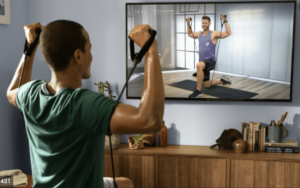 If the app interests you, Peloton is currently offering a 30 day FREE TRIAL, so why not give it a try? Check it out
If the app interests you, Peloton is currently offering a 30 day FREE TRIAL, so why not give it a try? Check it out 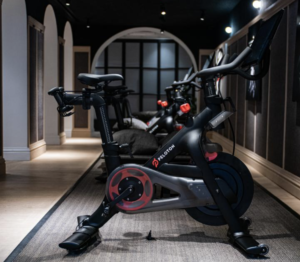

 This article would not be complete, however, if we did not acknowledge some of the delivery issues that have been plaguing Peloton over the last year. Most of the delivery issues seem to affect U.S. deliveries, however, the UK deliveries have been affected as well.
This article would not be complete, however, if we did not acknowledge some of the delivery issues that have been plaguing Peloton over the last year. Most of the delivery issues seem to affect U.S. deliveries, however, the UK deliveries have been affected as well.





